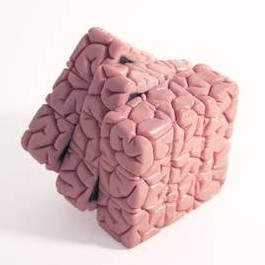Perceived Simultaneity Threshold: 100 milliseconds
Let me tell you how I got my nickname, Jaime “Three Frames” Griesemer.

Emily "Three Frames" Crazyhair
We were working on the melee animations for Halo 3, trying to get the timing right. There were already fast. Like, blink-and-you’ll-miss-it speed. The animators were having trouble because there wasn’t enough time to add a sense of anticipation and sell the impact properly. And for some unknown reason I wanted the damage keyframe to happen faster. “The melee animations can be as long as they need to be… as long as they’re exactly three frames.” We went back and forth about it, but eventually I traded three frame melee attacks for some extra flourish on the recovery after the hit. Everybody was happy.
Until the next day when I went back to try the new melee animations. I picked up the Assault Rifle. I pressed the B button. Three frames later, the butt of the rifle crunched into the face of a helpless alien invader. I picked up the Plasma Pistol. I pressed the B button. Three frames later, my left hook connected with a random marine that was looking at me funny. I picked up a shotgun. I pressed the B button. And for some unknown reason it didn’t feel right when I cracked open the head of a passing parasite. “Wait. That wasn’t three frames. Yeah, I’m sure, check the file. See… four frames!” (In hindsight, I’m lucky my uncompromising design demands didn’t earn me anything worse than a mocking moniker.)
What was the unknown reason? How could I tell the difference of only a single frame? Why did I insist on the speed at the expense of animation quality? The answer lies in our physiological limitations. What we experience as consciousness — as a stream of consecutive events in a clear and tidy order — is not nearly so neat. It’s a cacophony. A discordant mess. Your senses collect an incredible amount of information; they’re always on, always filling your nervous system with an unrelenting torrent of unfiltered data. It comes in at different speeds and at different times. The visual part is heavily processed, so it comes in late and is usually out-of-sync with the rest of your senses.
Your brain is used to this. It is, in fact, extremely good at taking all that information and combining it into a coherent experience. So good, it can take distinct events and merge them. Asynchronous events like pressing a button and seeing a melee attack. This feeling of simultaneity greatly increases the player’s connection with the action on-screen. Instead of a second-hand signal that transmits their intentions, pressing the B button becomes the act of dishing out a knuckle sandwich. But that requires your brain to blur over the delay and merge the movement of your thumb with the satisfying crunch.
Below a certain time threshold, the brain takes two events that are functionally separate — one causes the other and could not happen at the same time — and gives the impression that they were simultaneous. It turns out that threshold is around 100 milliseconds, or a little more than three frames. The reason four frames felt wrong was because the events were experienced as distinct, disassociated actions. The extra time allowed my brain to distinguish between them, in a sense inserting the controller as a step in the process and reminding me that I was not actually the one wearing metallic boxing gloves. So, for games where it is important to give the player a feeling of direct control, be careful of crossing the 100ms threshold.

